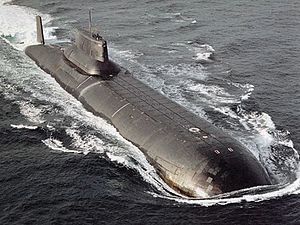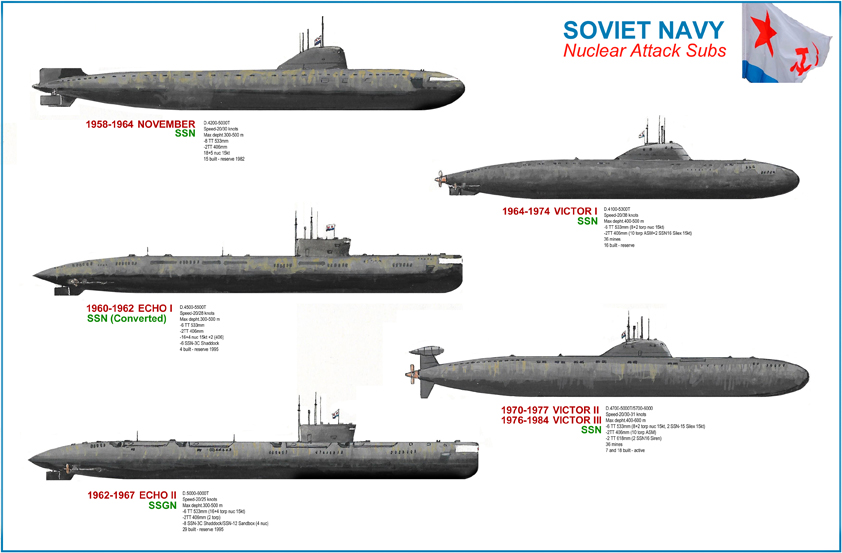USSR Submarines
In Soviet naval doctrine, the submarine is paramount as the most survivable asset that is able to strike the enemy hard, by using both speed and stealth to achieve devastating results. A contrary doctrine claims that submarine is the best weapon to protect the nuclear deterrence force in the form of SSBNs and keep American and NATO forces away from the Soviet littoral both on the Arctic and Pacific coasts. These two doctrines, while divergent in aim, are not mutually exclusive; striking the enemy fleet or commerce routes is an excellent way of keeping him occupied and away from your littoral, while maintaining a viable nuclear deterrence and maintaining the ability to strike (fleet in being) limits an enemies options. Doctrinal wrangling aside, the Soviets maintain twice as many submarines as the US and almost as many as all nations in NATO combined.

 All
Soviet subs are double hulled, meaning that they have a ‘Light Hull’ of
thin steel as an outer hull, forming the hydrodynamic shape of the boat.
The light hull allows the attachment of machinery, equipment and missile
tubes which will not affect the integrity of the inner hull. The much
stronger inner, or ‘Pressure hull’ which withstands the immense
compressive force that seawater at depth will apply against the hull.
Having a smaller pressure hull which is not penetrated by machinery or
missile tubes is much more efficient to construct as the inner hull is a
very complex, heavy and precise structure to build. The double hull also
adds a degree of survivability to Soviet subs as damage to the outer
hull does not affect the integrity of the inner.
All
Soviet subs are double hulled, meaning that they have a ‘Light Hull’ of
thin steel as an outer hull, forming the hydrodynamic shape of the boat.
The light hull allows the attachment of machinery, equipment and missile
tubes which will not affect the integrity of the inner hull. The much
stronger inner, or ‘Pressure hull’ which withstands the immense
compressive force that seawater at depth will apply against the hull.
Having a smaller pressure hull which is not penetrated by machinery or
missile tubes is much more efficient to construct as the inner hull is a
very complex, heavy and precise structure to build. The double hull also
adds a degree of survivability to Soviet subs as damage to the outer
hull does not affect the integrity of the inner.
With some exceptions most Soviet submarines have two reactors and most of the older boats have two propeller shafts. Newer attack submarines (SSN) only have one propeller and shaft but may have two reactors.
The Soviets have a habit of holding onto older equipment and converting it to new uses, this was happening long before the increased tensions of Northern Fury. One good example is the conversion of Yankee class ballistic missile submarines (SSBN) into; attack boats (SSN), two types of guided missile boats (SSGN), The Yankee Notch, and Yankee Sidecar, as well as several test bed projects and a mothership for mini-subs. One other practise in the Soviet Navy is to change names and hull numbers regularly, making the tracking of hulls confusing and somewhat of a guessing game.
In comparison to US and other NATO submarines, the Soviet subs are more rugged and probably more survivable, but also noisier and easier to detect, with generally less advanced and older technology. Reliability and safety is also an issue, five nuclear submarines have sunk since 1970, one of them twice, and several more have needed extensive refitting after fires. (compared to two US nuclear submarines sunk in the 1960s) However the story at this link shows how the Soviets can break the mold and should not be discounted from a technology standpoint.
